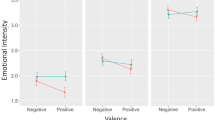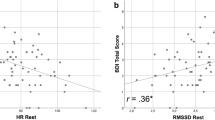Abstract
Cognitive reactivity—the tendency to think negatively in response to a sad mood—is an important predictor of depression vulnerability. The current study examined whether heart rate variability, a physiological index of emotion regulation capacity, predicts individual differences in cognitive reactivity. Heart rate variability in the high frequency spectrum was assessed during a 5-min rest period among a sample of healthy, female adults (N = 67). Participants then completed an assessment of dysfunctional attitudes before and after watching a movie designed to elicit a sad mood. Lower heart rate variability was associated with greater change in dysfunctional attitudes. This relationship persisted after controlling for (a) current depressive symptoms and history of depressive disorder, and (b) other physiological indices, including resting skin conductance, respiration, and heart rate. Findings suggest that low physiological capacity to regulate emotions may contribute to depression vulnerability via increased cognitive reactivity.

Similar content being viewed by others
References
Baxter, L. R., Jr., Schwartz, J. M., Phelps, M. E., Mazziotta, J. C., Guze, B. H., Selin, C. E., et al. (1989). Reduction of prefrontal cortex glucose metabolism common to three types of depression. Archives of General Psychiatry, 46, 243–250.
Beck, A. T., Rush, A. J., Shaw, B. F., & Emery, G. (1979). Cognitive therapy of depression. New York: Guilford.
Beck, A. T., Steer, R. A., & Brown, G. K. (1996). Beck depression inventory: Manual. San Antonio, TX: The Psychological Corporation.
Beck, A. T., Steer, R. A., & Garbin, M. G. (1988). Psychometric properties of the Beck Depression Inventory: Twenty-five years of evaluation. Clinical Psychology Review, 8, 77–100.
Beevers, C. G., & Carver, C. S. (2003). Attentional bias and mood persistence as prospective predictors of dysphoria. Cognitive Therapy and Research, 27, 619–637.
Beevers, C. G., Scott, W. D., McGeary, C., & McGeary, J. E. (in press). Negative cognitive response to a sad mood induction: Associations with polymorphisms of the serotonin transporter (5-HTTLPR) gene. Cognition & Emotion.
Beevers, C. G., Strong, D. R., Meyer, B., Pilkonis, P. A., & Miller, I. W. (2007). Efficiently assessing negative cognition in depression: An item response theory analysis of the dysfunctional attitude scale. Psychological Assessment, 19, 199.
Bench, C. J., Friston, K. J., Brown, R. G., Frackowiak, R. S., & Dolan, R. J. (1993). Regional cerebral blood flow in depression measured by positron emission tomography: The relationship with clinical dimensions. Psychological Medicine, 23, 579–590.
Berntson, G. G., Bigger, T. J., Eckberg, D. L., Grossman, P., Kaufmann, P. G., Malik, M., et al. (1997). Heart rate variability: Origins, methods, and interpretive caveats. Psychophysiology, 34, 623–648.
Bhagwagar, Z., Hinz, R., Taylor, M., Fancy, S., Cowen, P., & Grasby, P. (2006). Increased 5-HT2A receptor binding in euthymic, medication-free patients recovered from depression: A positron emission study with [11C]MDL 100, 907. American Journal of Psychiatry, 163, 1580–1587.
Bornstein, M. H., & Suess, P. E. (2000). Child and mother cardiac vagal tone: Continuity, stability, and concordance across the first 5 years. Developmental Psychology, 36, 54–65.
Buchsbaum, M. S., Wu, J., DeLisi, L. E., Holcomb, H., Kessler, R., Johnson, J., et al. (1986). Frontal cortex and basal ganglia metabolic rates assessed by positron emission tomography with [18F]2-deoxyglucose in affective illness. Journal of Affective Disorders, 10, 137.
Byrne, E. A., Slater, B. A., & Porges, S. W. (1991). Respiratory sinus arrhythmia (V) is stable over a 3-week period in adults. Psychophysiology, 28, (Suppl. 15).
Cannon, D. S., Tiffany, S. T., Coon, H., Scholand, M. B., McMahon, W. M., & Leppert, M. F. (2007). The PHQ-9 as a brief assessment of lifetime major depression. Psychological Assessment, 19(2), 247–251.
Caspi, A., Sugden, K., Moffitt, T. E., Taylor, A., Craig, I. W., Harrington, H., et al. (2003). Influence of life stress on depression: Moderation by a polymorphism in the 5-HTT gene. Science, 301, 386.
Dozois, D. J. A., Dobson, K. S., & Ahnberg, J. L. (1998). A psychometric evaluation of the Beck Depression Inventory-II. Psychological Assessment, 10, 83–89.
Drevets, W. C. (2003). Neuroimaging abnormalities in the amygdala in mood disorders. Annals of the New York Academy of Science, 985, 420–444.
Drevets, W. C., Videen, T. O., Price, J. L., Preskorn, S. H., Carmichael, S. T., & Raichle, M. E. (1992). A functional anatomical study of unipolar depression. Journal of Neuroscience, 12, 3628–3641.
Fabes, R. A., & Eisenberg, N. (1997). Regulatory control and adults’ stress-related responses to daily life events. Journal of Personality and Social Psychology, 73, 1107–1117.
Fracasso, M. P., Porges, S. W., Lamb, M. E., & Rosenberg, A. A. (1994). Cardiac activity in infancy: Reliability and stability of individual differences. Infant Behavior and Development, 17, 277–284.
Gemar, M. C., Segal, Z. V., Sagrati, S., & Kennedy, S. J. (2001). Mood-induced changes on the implicit association test in recovered depressed patients. Journal of Abnormal Psychology, 110, 282–289.
Gianaros, P. J., Van der Veen, F. M., & Jennings, J. R. (2004). Regional cerebral blood flow correlates with heart period and high-frequency heart period variability during working-memory tasks: Implications for the cortical and subcortical regulation of cardiac autonomic activity. Psychophysiology, 41, 521–530.
Gibb, B. E. (2002). Childhood maltreatment and negative cognitive styles: A quantitative and qualitative review. Clinical Psychology Review, 22, 223–246.
Gross, J. J., & Levenson, R. W. (1995). Emotion elicitation using films. Cognition and Emotion, 9, 87–108.
Grossman, P., Karemaker, J., & Wieling, W. (1991). Prediction of tonic parasympathetic cardiac control using respiratory sinus Arrhythmia: The need for respiratory control. Psychophysiology, 28, 201–216.
Grubbs, F. E. (1950). Sample criteria for testing outlying observations. Annals of Mathmatics and Statistics, 21, 27–58.
Hatch, J. P., Borcherding, S., & Norris, L. K. (1990). Cardiopulmonary adjustments during operant heart rate control. Psychophysiology, 27, 641–648.
Hayden, E. P., Dougherty, L. R., Maloney, B., Olino, T. M., Sheikh, H., Durbin, C. E., et al. (2008). Early-emerging cognitive vulnerability to depression and the serotonin transporter promoter region polymorphism. Journal of Affective Disorders, 107, 227–230.
Ingram, R. E., Miranda, J., & Segal, Z. V. (1998). Cognitive vulnerability to depression. New York, NY: Guilford.
Ingram, R. E., & Ritter, J. (2000). Vulnerability to depression: Cognitive reactivity and parental bonding in high-risk individuals. Journal of Abnormal Psychology, 109, 588–596.
Kessler, R. C., Berglund, P., Demler, O., Jin, R., Koretz, D., Merikangas, K. R., et al. (2003). The epidemiology of major depressive disorder: Results from the National Comorbidity Survey Replication (NCS-R). JAMA, 289, 3095–3105.
Lane, R. D., Reiman, E. M., Ahern, G. L., & Thayer, J. F. (2001). Activity in medial prefrontal cortex correlates with vagal component of heart rate variability during emotion. Brain and Cognition, 47, 97–100.
Lauritsen, J., & Bruus, M. (2008). Epidata Entry (Version 2.1): A comprehensive tool for validated entry and documentation of data. Odense, Denmark: The EpiData Association.
Lewinsohn, P. M., Solomon, A., Seeley, J. R., & Zeiss, A. (2000). Clinical implications of “subthreshold” depressive symptoms. Journal of Abnormal Psychology, 109, 345–351.
Mayberg, H. S., Liotti, M., Brannan, S. K., McGinnis, S., Mahurin, R. K., Jerabek, P. A., et al. (1999). Reciprocal Limbic-Cortical Function and Negative Mood: Converging PET Findings in Depression and Normal Sadness. American Journal of Psychiatry, 156, 675–682.
McNair, D. M., Lorr, M., & Droppleman, L. F. (1992). Edits manual for the profile of mood states (POMS). San Diego, CA: Educational and industrial testing service.
Meyer, J. H., McMain, S., Kennedy, S. H., Korman, L., Brown, G. M., DaSilva, J. N., et al. (2003). Dysfunctional attitudes and 5-HT2 receptors during depression and self-harm. American Journal of Psychiatry, 160, 90–99.
Miranda, J., Gross, J. J., Persons, J. B., & Hahn, J. (1998). Mood matters: Negative mood induction activates dysfunctional attitudes in women vulnerable to depression. Cognitive Therapy and Research, 22, 363–376.
Miranda, J., & Persons, J. B. (1988). Dysfunctional attitudes are mood-state dependent. Journal of Abnormal Psychology, 97, 76–79.
Ochsner, K. N., Bunge, S. A., Gross, J. J., & Gabrieli, J. D. E. (2002). Rethinking feelings: An fMRI study of the cognitive regulation of emotion. Journal of Cognitive Neuroscience, 14, 1215–1229.
Palomba, D., Sarlo, M., Angrilli, A., Mini, A., & Stegagno, L. (2000). Cardiac responses associated with affective processing of unpleasant film stimuli. International Journal of Psychophysiology, 36, 45–57.
Pan, J., & Tompkins, W. J. (1985). A real-time QRS detection algorithm. IEEE Transactions on Biomedical Engineering, 32(3), 230–236.
Pezawas, L., Meyer-Lindenberg, A., Drabant, E. M., Verchinski, B. A., Munoz, K. E., Kolachana, B. S., et al. (2005). 5-HTTLPR polymorphism impacts human cingulate-amygdala interactions: A genetic susceptibility mechanism for depression. Nature Neuroscience, 8, 828–834.
Porges, S. W. (1995). Orienting in a defensive world: Mammalian modifications of our evolutionary heritage: A Polyvagal Theory. Psychophysiology, 32, 301–318.
Riese, H., Rosmalen, J. G. M., Ormel, J., Van, R., Arie, M., Oldehinkel, A. J., et al. (2007). The genetic relationship between neuroticism and autonomic function in female twins. Psychological Medicine, 37, 257.
Rottenberg, J., Gross, J. J., Wilhelm, F. H., Najmi, S., & Gotlib, I. H. (2002). Crying threshold and intensity in major depressive disorder. Journal of Abnormal Psychology, 111, 302–312.
Ruiz Padial, E., Sollers, J. J., III, Vila, J., & Thayer, J. F. (2003). The rhythm of the heart in the blink of an eye: Emotion-modulated startle magnitude covaries with heart rate variability. Psychophysiology, 40, 306–313.
Scher, C. D., Ingram, R. E., & Segal, Z. V. (2005). Cognitive reactivity and vulnerability: Empirical evaluation of construct activation and cognitive diatheses in unipolar depression. Clinical Psychology Review, 25, 487.
Schinka, J. A., Busch, R. M., & Robichaux-Keene, N. (2004). A meta-analysis of the association between the serotonin transporter gene polymorphism (5-HTTLPR) and trait anxiety. Molecular Psychiatry, 9, 197.
Segal, Z. V., Gemar, M., & Williams, S. (1999). Differential cognitive response to a mood challenge following successful cognitive therapy or pharmacotherapy for unipolar depression. Journal of Abnormal Psychology, 108, 3–10.
Segal, Z. V., Kennedy, S., Gemar, M., Hood, K., Pedersen, R., & Buis, T. (2006). Cognitive reactivity to sad mood provocation and the prediction of depressive relapse. Archives of General Psychiatry, 63, 749–755.
Soares, J. C., & Mann, J. J. (1997). The functional neuroanatomy of mood disorders. Journal of Psychiatric Research, 31, 393.
Spitzer, R. L., Kroenke, K., Williams, J. B. W., & The Patient Health Questionnaire Primary Care Study Group. (1999). Validation and utility of a self-report version of PRIME-MD: The PHQ primary care study. Journal of the American Medical Association, 282, 1737–1744.
Task Force of the European Society of Cardiology and the North American Society of Pacing and Electophysiology. (1996). Heart rate variability: Standards of measurement, physiological interpretation, and clinical use. European Heart Journal, 17, 354–381.
Taylor, L., & Ingram, R. E. (1999). Cognitive reactivity and depressotypic information processing in children of depressed mothers. Journal of Abnormal Psychology, 108, 202–210.
Thayer, J. F., & Lane, R. D. (2000). A model of neurovisceral integration in emotion regulation and dysregulation. Journal of Affective Disorders, 61, 201–216.
Weissman, A. (1979). Dysfunctional Attitudes Scale: A validation study. Unpublished doctoral dissertation: University of Pennsylvania, Philadelphia.
Acknowledgments
The authors thank members of the Mood Disorders Laboratory at the University of Texas at Austin for help with data collection.
Author information
Authors and Affiliations
Corresponding author
Rights and permissions
About this article
Cite this article
Beevers, C.G., Ellis, A.J. & Reid, R.M. Heart Rate Variability Predicts Cognitive Reactivity to a Sad Mood Provocation. Cogn Ther Res 35, 395–403 (2011). https://doi.org/10.1007/s10608-010-9324-0
Published:
Issue Date:
DOI: https://doi.org/10.1007/s10608-010-9324-0




